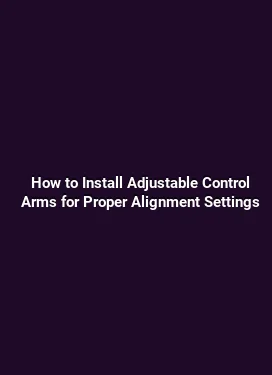How to Upgrade Suspension for Autocross: A Practical Setup Guide
Autocross demands rapid transitions, precise cornering, and consistent lap times. The suspension system, which connects the tires to the chassis, plays a pivotal role in how a car responds to these demands. Upgrading suspension components is not just about making the car stiffer; it is about achieving the right balance among grip, predictability, weight transfer, and ride quality on a variety of tight cones and surfaces. This guide dives into the practical steps, proven approaches, and real-world considerations for building a competitive autocross suspension package that can adapt to different courses and driver preferences.
Fundamentals of Autocross Suspension: What Really Matters

Autocross courses are characterized by tight turns, rapid direction changes, and closed pavement conditions. The suspension system must translate driver input into confident tire contact with the surface. Several interrelated factors determine overall handling: ride height and alignment geometry, spring rates and damping, anti-roll stiffness, suspension travel, and chassis rigidity. Rather than chasing extreme numbers in isolation, a successful setup achieves coherent responses under transient loads, enabling consistent grip and predictable tire wear across a long event day.
Key performance aspects to consider include roll stiffness distribution, camber management, and toe behavior under dynamic conditions. A well-tuned system minimizes excessive body roll without sacrificing front-end bite or rear stability. It also preserves tire contact patch during cornering, accelerating, and braking, which directly influences lap time and consistency. Understanding these interactions helps in selecting components and tuning strategies that align with both the vehicle’s baseline geometry and the driver’s style.
Componentry: What to Upgrade First for Autocross
Upgrading suspension begins with choosing the right hardware that delivers tangible gains without compromising daily driveability or reliability. The typical upgrade path focuses on three core areas: springs and dampers, anti-roll bars, and bushings or mounts. Each area contributes to different aspects of handling and stability, and the best approach often combines improvements across all three in a synergistic way.
Springs and dampers form the foundation of how the car resists and recovers from track-driven disturbances. A common strategy is to select springs that provide a controlled amount of ride harshness, enabling the tires to maintain contact while still supporting aggressive weight transfer during cornering. Dampers then shape how quickly the suspension responds to inputs, controlling rebound and compression to minimize oscillations and maintain tire contact through transitions. The aim is a balanced, linear response across the suspension’s travel range that remains predictable at the limit.
Anti-roll bars, or sway bars, influence roll stiffness distribution between the left and right sides. A stiffer bar reduces body roll, helping the inside tire stay more loaded through a corner. However, too much roll stiffness can degrade mechanical grip and destabilize the car in certain transitions. The goal is a bar that complements the springs and dampers, preserving front-end bite while keeping the rear planted during quick direction changes.
Bushings and mounts affect noise, vibration, and the precision of steering feedback. Upgrading to higher-quality, performance-oriented bushings can reduce unwanted flex and improve steering feel. It is important to condition these parts to maintain predictable responses and long-term reliability, especially in autocross where repeated, high-load cornering is common.
Choosing Springs, Dampers, and Bar Sizes

Spring rates should be matched to the vehicle’s weight, power, and chassis stiffness. A practical starting point is to select springs that offer a balance between support and wheel travel, then fine-tune with dampers to control compression and rebound. In many autocross setups, front and rear spring rates are not identical; the aim is to achieve harmonious load transfer across the axle pair to maintain consistent grip through all segments of a course.
Damping characteristics are highly dependent on the damper design and internal valving. For autocross, a damper with predictable, linear response helps reduce surprise at the limit and makes tire behavior easier to predict. Adjustable dampers provide an opportunity to tailor the setup to different courses, weather conditions, and driver preferences, while non-adjustable units offer repeatable behavior with less complexity.
Bar sizing should be selected to complement the spring rate and the desired balance between front and rear grip. A general approach is to start with a modest increase in anti-roll stiffness, then adjust through testing to observe changes in turn-in, mid-corner stability, and exiting grip. The goal is to reduce excessive roll without destroying the tire’s ability to regain contact after a corner exit, which is critical for quick lap times.
Alignment and Geometry: How Small Angles Make a Big Difference
Alignment settings are among the most impactful factors for autocross performance. Small changes in camber, toe, and caster can dramatically alter contact patch behavior, steering feel, and turn-in performance. The objective is to optimize the tire’s contact with the road as load transfers across a variety of speeds and steering angles.
Camber is particularly important on a car with performance tires, where a modest negative camber can improve cornering grip by maintaining a larger contact patch on the outside tire during a turn. However, excessive camber can reduce grip in straight-line braking or on entry, so it should be dialed in carefully using data from corner entries and exits. Adjusting toe, especially in the front, helps with steering accuracy and early turn-in response. A tiny toe-out on the front axle can improve turn-in without causing excessive instability; misalignment on the rear often manifests as oversteer that is difficult to control under rapid direction changes.
Caster angle affects steering feel and self-centering characteristics. A slightly larger caster can improve steering feedback and straight-line stability, which helps when navigating a course with frequent changes in direction. Real-world tuning involves testing on track days or autocross events, recording grip under various speeds, and correlating with driver input and tire wear data.
Ride Height and Dynamic Geometry Considerations
Static ride height is just part of the story. Dynamic ride height changes as the suspension compresses under load, and these changes influence camber and bump steer. A lower ride height generally reduces center-of-gravity effects and minimizes roll, but it can also reduce suspension travel and increase the risk of bottoming out on rough surfaces. For autocross, a moderate, well-supported ride height that preserves enough travel to absorb small bumps is often ideal, particularly on courses with imperfect pavement or surface changeovers.
Bottoming resistance and bump steer are practical concerns in tight autocross settings. Upgrades such as performance springs with compatible dampers and properly calibrated steering linkage can reduce unwanted steering changes during heavy compression. This improves driver confidence when entering tight apexes and rapidly changing lines.
Tuning Strategies: From Baseline to Competitive
Moving from a baseline setup to a competitive autocross configuration requires a structured approach. Start with a controlled baseline that emphasizes repeatability and predictable behavior, then gradually introduce modifications that offer tangible benefits under test conditions that resemble race day scenarios. A typical tuning cycle looks like this: measure, adjust, test, and compare against a consistent benchmark. Documenting every change and its effect on grip, balance, and lap time is essential for incremental improvement.
One effective strategy is a stepwise adjustment of front and rear spring rates to achieve a balanced roll feel. If the car understeers through mid-corner and the rear remains planted, consider increasing rear spring rate or rear damping to improve balance. Conversely, if the front end dominates steering input or the car pushes toward understeer, a front stiffening or improved front damping may be warranted. Small, measured changes prevent destabilizing the car and allow for reliable data collection across multiple laps and drivers.
Another technique is progressive damping, where the damper’s rate changes with velocity. This helps the suspension respond smoothly at low-speed transitions yet become firmer under high-load conditions, keeping the tires in contact with the surface through demanding sections of a course. The result is improved turn-in precision and more consistent exit traction, which translates into quicker, repeatable laps.
Tire Interaction: The Final Link in the Chain
All suspension upgrades must align with tire characteristics. The tire is the only component that directly interacts with the road, so the suspension should be tuned to maximize tire performance. Achieving proper contact patch, minimizing slip angles, and maintaining stable slip distribution across the tire contact area enhances grip and predictability. When upgrading suspension, verify that the tire pressures, tread temperature distribution, and operating temperatures stay within the optimal window for the course surface. This alignment between suspension and tires is key to consistent performance across a wet or dry autocross event.
Practical Roadmap: From Purchase to Course Day
Developing a practical upgrade plan involves a phased approach, factoring in budget, vehicle compatibility, and the driver’s experience. The following roadmap outlines a structured path from initial assessment to on-course performance gains.
- Baseline assessment: Record current handling characteristics, including turn-in response, mid-corner stability, and exit traction. Note ride quality and any dashboard indicators of poor chassis response.
- Component selection: Choose springs, dampers, and sway bars with an emphasis on predictable behavior and drivability on non-ideal surfaces. Ensure compatibility with the vehicle’s chassis and mounting points.
- Alignment strategy: Establish a starting point for camber, toe, and caster aligned with tire type and course expectations. Plan for subsequent tuning after initial test runs.
- Rigidity considerations: Inspect subframe mounts, chassis bushings, and steering rack mounts for play. Upgrade or replace worn parts to minimize unintended geometry changes under load.
- Test and document: Conduct controlled test sessions to compare the baseline against the upgraded setup. Use objective metrics such as lap times, exit speeds, and tire wear patterns to evaluate progress.
- Weather and surface adaptation: Prepare adjustments for varying course conditions, including dampers with easy adjustability and bar settings that can be tuned quickly between events.
For many drivers, the most meaningful gains come from incremental changes and disciplined testing. By focusing on tangible improvements in turn-in response, tire contact, and mid-corner stability, autocross setups can quickly become more competitive without introducing excessive complexity or maintenance concerns.
Common Pitfalls and How to Avoid Them
Even well-intentioned upgrades can backfire if implemented without careful consideration. Common pitfalls include over-stiffening the chassis, which reduces mechanical grip and makes the car twitchy at the limit; misaligning toe, which can induce unstable steering; and selecting dampers that are ill-suited to the car’s weight distribution or driving style. The best defense is a methodical approach: validate every change with data, avoid large, untested leaps in settings, and maintain a consistent baseline for comparison.
Additionally, weather and surface quality can dramatically influence how a suspension upgrade behaves. Always consider seasonal changes, asphalt texture, and temperature when planning tuning sessions. Recording environmental conditions alongside performance metrics helps ensure that improvements are genuine and not merely situational.
Real-World Case Study: A Practical Example of an Autocross Upgrade
A compact rear-wheel-drive car used in a regional autocross series benefited from a carefully staged upgrade path. The team started with a modest spring rate increase and a dampers package that offered 16 levels of rebound adjustability. After monitoring on a variable-cone layout, the driver reported crisper turn-in and reduced mid-corner understeer. The next step involved a slight increase in rear anti-roll stiffness and a revised front camber to balance grip during exit. The net result was a more predictable car that could carry higher cornering speeds through the apex. The setup remained comfortable enough for daily use, demonstrating that performance upgrades can coexist with reliability and practicality.
This example illustrates the importance of aligning hardware upgrades with driving goals and course characteristics. Without a clear plan and objective data, even a well-built suspension can fail to deliver meaningful improvements on the course.
Maintenance, Longevity, and Track Readiness
Suspension components require routine inspection and maintenance to deliver consistent performance over time. Regularly check for signs of wear on bushings, mounts, and pivot points. Inspect springs for sag or misalignment and monitor damper seals for leaks. A maintenance routine that includes cleaning, torque verification, and periodic alignment checks helps sustain the gains achieved through upgrades. Keeping a log of part numbers, wear observations, and service intervals accelerates future tuning and ensures that the car remains track-ready throughout the season.
In addition to mechanical maintenance, ensure that the vehicle’s overall handling baseline remains consistent. Tire wear patterns, tire pressures, and wheel alignment should be revisited after events, especially when adjusting suspension settings to different courses. A measured maintenance and monitoring process supports continuous improvement and reduces the risk of unexpected handling changes on event day.
Conclusion: Building Confidence Through Informed Upgrades
Upgrading suspension for autocross is a disciplined, data-driven process that blends mechanical understanding with practical testing. By selecting compatible components, tuning to harness tire grip, and refining alignment and geometry, drivers can achieve a more predictable, confident, and rewarding autocross experience. The emphasis remains on coherent, balanced improvements rather than isolated, extreme changes. With careful planning, consistent testing, and attention to maintenance, a well-executed suspension upgrade becomes a meaningful contributor to faster, more repeatable laps and a more enjoyable driving experience on every course.






